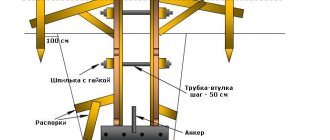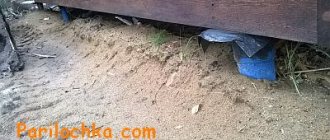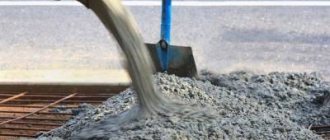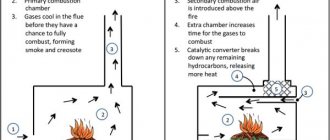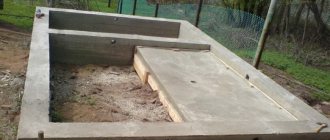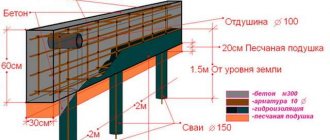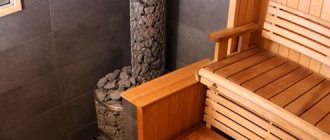Selection and technology of building a foundation for a bathhouse.
A modern bathhouse is a lightweight structure made of logs or timber that can stand on any type of foundation. When choosing a foundation, you need to take into account the characteristics of the soil on the site and economic feasibility - extremely reliable foundations made of a monolithic slab or reinforced concrete piles for a small bathhouse with an area of up to 6x6 m will simply be unnecessary.
What is the best foundation for a bathhouse? Forum.
Bathhouse on a strip foundation.
In this article we will look at the optimal types of foundations for a bathhouse, give recommendations on their calculation and DIY technology. Strip, columnar, screw and slab foundations, as well as cheap tire foundations, will be examined in detail.
Choosing a foundation for a bathhouse.
When choosing which foundation is best for a bathhouse, you need to consider three factors:
- weight and size characteristics of the structure;
- geological conditions on the site - presence of a slope, type of soil and its bearing capacity, freezing depth and groundwater level;
- budget allocated for construction.
In most cases, the best option would be a strip foundation for a bathhouse . The different depths of the strip foundation allow you to build in any soil conditions - on stable soil it is rational to construct a shallow strip (deepened by 30-80 cm), in heaving soil - deep strips (the support base is 20-30 cm below the depth of soil freezing).
However, the arrangement of a buried foundation is accompanied by serious costs for materials, and in order to save money, it is better to give preference to screw or columnar foundations.
The screw foundation for a log bathhouse consists of steel piles tied with a grillage, the blades of which open the surface layer of soil and rest on solid deep soil. The advantages of this option are low cost, quick installation time (installing a foundation for a bathhouse takes 2-3 days) and reliability.
What is the best foundation for a bathhouse?
Shallow strip foundation for a bathhouse.
A good analogue for the construction of light buildings (log house, frame panels - area from 3x3 to 6x6 m) is a bathhouse on a columnar foundation. To install a log bathhouse on poles, the soil on the site must not be prone to horizontal shifts, otherwise there is a high risk of the supports overturning. The pillars can be monolithic (concreted asbestos pipes) or prefabricated (from FBS blocks).
In complex soils - mobile, heaving and low-density - a foundation slab is needed. This is a monolithic structure made of reinforced concrete 30-50 cm thick, the dimensions of which correspond to the area of the building. The slab is a reliable and durable foundation for a frame bathhouse or log house, but its cost is higher than other analogues.
A simple foundation for a bathhouse, suitable for light frame buildings measuring 3x3 and 3x4 m - a base made of car tires. It is possible to erect a building on such a foundation in stable soil that is not prone to heaving. A bathhouse without a foundation can only be built on rocky soils.
Collection of characteristics and calculation of the foundation.
Before building a foundation for a bathhouse with your own hands, you need to calculate the foundation and find out whether it will withstand the building in specific soil conditions. You need to determine the type of soil on the site (sandy, clayey, sandy loam) and, using standard tables, find out the value of its resistance per 1 cm2.
Next, you need to calculate the loads that will be transmitted by the foundation to the soil. Load calculations are performed using the following algorithm:
- Calculation of the mass of a building - the weight of the roof, floors and walls is separately calculated and summed up by multiplying their area by the specific weight of the building material (tabular data).
- Calculation of snow loads - multiply the roof area by the weight of m 2 of snow cover in your region.
- Calculation of operational loads (furniture, stove, wall cladding) - multiply the area of the basement floor by the average load of 100 kg.
- Calculation of total loads - we summarize the obtained data and add a safety margin by multiplying the amount by 1.2.
It remains to determine the supporting area of the foundation, multiplying its perimeter by its width, and calculate the load per 1 cm 2 of soil.
For example: the standard width of the tape for log walls is 30 cm, for a bathhouse with an area of 6 × 6 m (perimeter 24 m), its supporting area will be - 240 * 30 = 7200 cm 2. for a 3 × 3 building - 3600 cm 2. for 3x4 bath - 4200 cm 2. and so on. Now you need to divide the total loads by the supporting area and compare the resulting value with the resistance of 1 cm 2 of soil; if the result exceeds the bearing capacity, you will need to increase the area where the foundation rests on the ground by adding the width of the tape or the diameter of the pillars.
Frame
Frame-panel structures became popular among consumers several years ago. They are quite easy to assemble and do not require a large amount of natural wood or special equipment.
An inexpensive frame bathhouse is placed on a lightweight foundation, most often a columnar one is chosen. This significantly reduces construction costs since it does not require as much concrete to pour the foundation.
The walls of the bathhouse are most often mounted from ready-made frames, which are immediately manufactured in the workshop. If desired, to further reduce costs, you can assemble the frame yourself, but this will slow down construction. To create good thermal insulation and for a long service life of the building, it should be sheathed with suitable boards. To save money, coniferous species are suitable.
Attention! For frame baths, timber and logs are often used. But these materials are very expensive, although they are of excellent quality and long service life. Unplaned timber will allow you to save as much as possible on material. It is not as beautiful, but very affordable.
Since frame baths have thin walls, they require mandatory insulation. Among inexpensive insulation materials, mineral wool is most often chosen. It is laid in the walls in the form of slabs. They are not only affordable, but are also reliable and have a long service life, provided they are installed well.
Attention! When building frame-panel baths, you cannot skimp on protecting the frame and vapor barrier. If you have very little money, then give your preference to polymer film and aluminum foil. They are quite hopeful and belong to the economy segment.
Do-it-yourself foundation construction technology.
When considering the question of how to make a foundation for a bathhouse, we focus on the fact that the floor slab of the bathhouse must be equipped with a drain, which is installed at the stage of pouring the foundation.
In the wall of the strip foundation it is necessary to provide a hole for the drainage pipe, and the floor of the bathhouse itself - a concrete screed or a joist floor, should be made with a slope towards the central part, in which a drain hole covered with a metal mesh is placed. The water is discharged through a pipe into a storage well located outside the bathhouse at a distance of 2-3 meters.
Strip foundation.
A shallow strip foundation is the optimal solution for building a log bathhouse with an area of 4×6 to 6×6 m. The supporting part of the MLF is placed at a depth of 30-50 cm, and 20-30 cm of strip is also formed above the ground level, which is used as a base.
Let's look at how to properly pour the foundation for a bathhouse:
What is the best foundation for a bathhouse on loam?
Strip foundation diagram.
- The foundation is marked - its design contours are transferred to the site using reinforcement pegs and twine.
- Using shovels, a trench is dug to the depth of the tape plus 20 cm under the compacting bedding;
- A layer of sand 10 cm thick is formed at the bottom of the trench, and on top of it is a layer of crushed stone of similar thickness. The bedding is carefully compacted by compaction.
- Outside the trench, formwork is installed from boards 1-2 cm thick, which will form the ground part of the tape. The structure is strengthened with stakes and spacers. The trench and formwork walls are covered with waterproofing material.
- The foundation is reinforced with a double-circuit frame made of reinforcement with a diameter of 12-16 mm. The upper and lower belts of the foundation are connected by vertical jumpers in increments of 40 cm. Proper reinforcement of the corners of the tape - the frame should not be connected by a cross joint, but by rods curved at right angles.
- After the reinforcement is completed and the assembled frame is installed in the formwork, the shallow foundation is concreted with concrete grade M200-M300.
The formwork is dismantled 2 weeks after pouring, after which the floor can be laid out and the walls of the log house can be raised. The floor will need to be insulated to prevent heat loss from the bath through the ceiling. If you are making a joist floor, insulation (mineral wool, polystyrene foam or EPS) is laid between the joists and covered with facing boards.
Waterproofing the insulation is important - it needs to be covered on both sides with a PVC membrane that prevents the material from rotting under the influence of high air humidity. Waterproofing is also laid along the upper contour of the tape on which the basement of the bathhouse is placed.
Construction of a strip foundation (video).
Columnar foundation.
It is rational to make a columnar foundation for a bathhouse with your own hands from concreted asbestos pipes, deepened below the freezing level of the soil - in this case, the log house will be protected from heaving. The pillars are tied with a grillage made of timber or channel.
Let's look at how to pour a foundation for a bathhouse:
- The contours of the foundation are marked on the site and the installation points of the supports are indicated.
- Using hand-held drilling tools, wells are developed for the installation of pillars (the optimal diameter of asbestos pipes is 25-30 cm, the depth of the foundation is 2 m).
- The pipes are installed in the well, they are reinforced with 4 reinforcement bars of 10th diameter (the rods are stuck into the ground).
- M300 concrete is poured into the pipes, until the mixture has hardened, a steel pin (a rod 40-50 cm long with a threaded thread) is inserted into the central part of the column to secure the grillage. The stud should protrude to the thickness of the grillage and penetrate into the concrete by at least 20 cm.
- The post is tied with a grillage made of timber with a cross-section of 15×20 cm. The beam is cut to size, groove joints are cut out in the joining parts, after which the strapping is laid on the supports. At the points of connection with the posts, a through hole is drilled in the timber for the pin and a seat for the fixing nut (using a feather drill).
What is the best foundation for a bathhouse with your own hands?
Foundation made of tires for a bathhouse.
Before laying the grillage, the pillars must be waterproofed - roofing material or glass insulation is placed on their end part under the timber.
Tire foundation.
The technology for arranging a budget foundation made of tires for a small log house or a light frame bathhouse is extremely simple to implement—neither reinforcement nor waterproofing is required. To work, you need 10-15 tires from a passenger car ( diameter 60-70 cm ).
The distribution of tires is as follows - one at a time in the corners of the log house and evenly, in increments of 1 m, along the perimeter of its walls. Initially, you need to make a pit for the entire area of the bathhouse with a depth of 15-20 cm, fill it with crushed stone, level it and compact the bedding tightly.
Next, mark the contours of the log house and use pegs to indicate the placement of the tires. Having centered the tires on the pegs, cover their bottom with geotextile and fill with crushed stone, not reaching 5 cm to the top. The crushed stone is compacted and the remaining space is filled with cement-sand mortar.
To prevent the tires from being destroyed during operation due to the scorching sun, they need to be covered with glass insulation, after which you can begin laying the bottom frame timber and raising the walls.
What kind of foundation should be built for a bathhouse?
- Why take into account the type of soil on the site?
- Types of foundations for a bathhouse Columnar brick foundation
- Screw foundation for a bathhouse
- Floating foundation
To make the bathhouse strong and reliable, special attention should be paid to the base. Today, it is possible to use various foundations, but the appropriate one must be selected taking into account the type of soil and other construction conditions. Shallow strip foundations, pile foundations and support foundations are suitable as a foundation for a bathhouse. The technology for building foundations is not so complicated; the foundation can be built independently, without involving expensive construction teams.
What is the best foundation for a bathhouse?
Foundation design diagram.
From aerated concrete
In its characteristics, this material is similar to foam blocks. Aerated concrete blocks are made from a mixture of cement, sand, aluminum mixture and special gas-forming substances. During a chemical reaction, the mixture hardens, and pouring into special molds allows the block to be given the correct shape.
Aerated concrete baths are prefabricated, lightweight, and do not require the construction of a solid foundation. In terms of ease of processing, the material is comparable to wood; it is easy to cut and assemble.
In terms of thermal insulation properties, aerated concrete blocks are not inferior to timber, which allows you to build a very warm and strong bathhouse. The special composition of the material allows you to avoid the appearance of mold and mildew, but you should understand that this requires proper ventilation.
The blocks do not burn, and when exposed to high temperatures they do not emit any harmful substances or toxins.
The only drawback of aerated concrete is its high ability to absorb water. This is due to the porous structure of the material. To prevent a reduction in the service life of the bathhouse and destruction of the concrete structure, good waterproofing is required. Particular attention should be paid to this work in the steam room and washing room. The floor in such baths should always be left wet and not insulated with anything.
Attention! Aerated concrete does not shrink significantly; it does not exceed 1-2%. This moment allows you to immediately begin decorating the steam room and dressing room.
Why take into account the type of soil on the site?
Before starting work, it is necessary to conduct a soil study. This will help to correctly determine what type of base is suitable and what loads it can withstand. The soil on the site should not sag or experience maximum heaving.
The soil must be homogeneous, in which case there will be no deformation of the structure, subsidence, or uneven shrinkage.
What is the best foundation for a bathhouse?
Diagram of a pile foundation.
It is not recommended to carry out construction work on peat bogs, on heavily silty soil, or on sand, since even a pile foundation will not always be able to provide the required reliability. If there is no choice, you will have to completely replace part of the soil on the site with a bed of coarse sand. This layer must be spilled with water and compacted. There may be two optimal options:
- for water-saturated soil, you need to choose a pile foundation made of metal screw piles;
- for areas with high groundwater levels, a monolithic slab foundation, often called a floating foundation, is preferable;
- for other types of soil, you can use strip, simple support, or regular slab foundations.
The depth of the foundation should not be less than 50 cm, since in winter such a structure can simply be pushed upward, and in spring and summer it will sag a little due to thawing of moisture in the soil. To prevent this from happening, it is necessary to design the base in advance and determine the depth of the structure.
Two important differences: shallow or deep
Before considering the types of foundations in detail, two main types should be distinguished - shallow and deep . The difference is in the depth of immersion in the ground. Why is this moment important?
In winter, the top layer of soil freezes, and all the moisture in it turns into ice. When it freezes, it expands, causing the top layer of soil to change its volume. This phenomenon is called “ frost heaving ”, it is typical for soils with a high moisture content, clay and loam.
The depth of soil freezing depends on average annual temperatures and soil composition. For deep ones, the basic rule is to immerse below the freezing point to eliminate the effects of heaving loads. For some areas, this type is difficult to implement - the soil can freeze to 2.4 meters. There is a way out.
A shallow type is used , the feature of which is a shallow immersion depth.
Such a foundation is located in the upper layers of the soil, above the freezing point, but the loads from heaving processes are much lower - 2 or even 3 times. The point is to properly arrange the foundation: the trench is dug a little wider, a sand cushion is installed, a concrete strip is erected, which is subsequently filled with sand on the sides. As a result, there is a sand cut-off on all sides.
Sand does not retain moisture; it goes deeper in warm weather, so there is nothing to freeze in winter.
Only loads emanating from the lower layers of the soil remain, so it is impossible to use a shallow type of foundation on soils with large seasonal heaving .
Types of foundations for a bathhouse.
What is the best foundation for a bathhouse?
Diagram of pile formation stages.
Which foundation is most suitable for a bathhouse? Attention should be paid to such parameters as the soil, the material used to make the bathhouse itself, and its dimensions. A strip foundation is one of the best options for almost any low-rise building. This base is made in the form of a concrete or stone (brick) strip around the perimeter of the building. The laying of the tape is not very large, usually up to 60 cm, the upper part should protrude by 30 cm, the width of the tape is 40 cm (depending on the thickness of the wall). Often such a foundation is chosen by novice builders as the simplest and fastest option to construct.
At the first stage, it is necessary to mark along the perimeter of the tape and under the load-bearing walls, and then dig a pit. A cushion of sand and crushed stone is poured onto the bottom of the pit, it is moistened with water and compacted. Then you need to install the formwork and make an armored belt from metal rods. The tape is poured with concrete mortar, after which it must be left to dry for about 3-4 weeks. The surface of the concrete should be moistened with water for the first days and protected with a film from possible rain. After the concrete has dried, it is necessary to waterproof it with roofing felt and tie it with a wooden board.
Columnar foundation made of brick.
The columnar foundation for the bathhouse is built from brick. This is a support type of foundation, which is recommended for difficult soils, for frame and wooden baths. The technology for constructing such a foundation is as follows:
What is the best foundation for a bathhouse?
Scheme of a columnar foundation.
- first, the area for the foundation is marked, the location of the supports is determined;
- holes are dug for future supports, their cross-section must be square, not less than 38 cm. The supports should be located around the perimeter, in the corners of the building, under load-bearing walls and at the points of their connection with external ones;
- the walls of the wells are lined with roofing felt, and a cushion of sand and crushed stone is poured onto the bottom. After this, the supports are poured to the ground level, and masonry of the required height is performed on top;
- the strapping is made of wooden beams or metal beams; such a belt must be protected with two layers of roofing material.
This type of foundation is needed if the structure is small and the load on the ground is minimal.
Screw foundation for a bathhouse.
The screw foundation today is considered one of the simplest and most reliable; it can be built even on very difficult soils. Among the advantages of such a base for a bathhouse, it should be noted:
- possibility of installation on almost any type of soil, even swampy;
- strength and stability;
- quick and not very complicated installation.
The only negative would be the lack of possibility of constructing a basement floor, but even in this case, a way out of the situation can be found. To do this, a shallow trench is dug around the perimeter, then intermediate walls are laid out of brick between the individual foundation piles. When constructing the base, ventilation holes are provided in the masonry, and the entire structure is waterproofed. For masonry, you need to use red brick; silicate brick is not suitable in this case.
Floating foundation.
Which foundation to choose for a bathhouse? For a stone or brick bathhouse that will be built on water-saturated soils, it is recommended to install a concrete monolithic foundation, the so-called floating foundation. This is a rectangular slab, which is excellent for heaving, weak-bearing, heavy, bulk and other complex types of soil. The construction technology is not complicated, although the work itself is quite financially expensive.
First, you need to dig a hole with suitable dimensions for the future foundation, cover the bottom with a layer of sand and crushed stone with a height of about 60 cm. After this, the cushion layer is moistened with water and compacted. The next stage is waterproofing; special films can be used to protect the surface. Additionally, collapsible formwork is installed from regular edged boards. Before filling, you need to make reinforcement. To do this, using metal rods and knitting wire, 2 armored belts are made, the rods of which should not protrude after pouring on the sides and top.
The formwork is completely filled with concrete and then left to dry completely. To prevent cracking from occurring, it is recommended to moisten the surface of the slab with water and cover it with damp burlap and wet sawdust. This will make the drying process high-quality and correct. After the foundation has dried, which may take up to 28 days, you can begin waterproofing, that is, treat the surface with molten bitumen or cover it with 2 layers of roofing felt. Then you can start building the bathhouse itself.
How to make a pile foundation?
For loose soils, a regular strip or columnar one is no longer suitable, so a pile one must be installed. It will stand firmly and reliably even on swampy soil, distributing all the loads from the structure. The technology for constructing such a foundation is extremely simple; you only need to drive piles into the ground, and then connect them on top with a special belt in the form of beams, which serves as the foundation for the bathhouse.
To install a pile foundation for a bathhouse, you must first calculate all the dimensions. To do this, the pitch between the piles is determined and their total number is calculated. The distance between the support pillars should be between 1.4-2.6 m, each pillar should have a cross-section of 38 cm. The supports should be located in the corners of the building, along the perimeter, under the load-bearing walls. For auxiliary pillars, you can take a slightly smaller cross-section, for example, for square ones 38x25 cm is quite suitable.
After the calculations, you need to prepare the following materials:
- metal and asbestos cement, in some cases brick;
- cement;
- metal beams.
The foundation begins with clearing the site for construction; it is necessary to remove all debris, remove a layer of fertile soil, and install markings around the perimeter. If screw piles are used, you need to mark the points where they will be mounted, and then begin screwing them. Several people can easily handle such work; no special heavy construction equipment is required. All piles must be installed at the same depth. They are cut from above so that they have the same level. Their height should not be large; usually 30-40 cm is enough. After this, you need to prepare a concrete solution and pour it into each pipe.
When the cement has dried, you can begin constructing a belt of metal beams that act as the basis for the construction of the bathhouse itself. Such a pile foundation makes it easy to connect the sewer system and ensure the removal of all excess water from the bathhouse without the need to build a separate system under the floor.
Which foundation for a bathhouse is most suitable? When answering this question, it is necessary to pay attention to various circumstances. These are the type of soil, the size of the bath itself, the material from which it will be built. For wooden and frame baths, it is best to use lightweight types of foundations, and for a stone or brick structure it is recommended to install a reliable slab or strip foundation.
Marking
Marking scheme for a strip foundation
We will make markings based on the large-scale project of the future bathhouse. It will be necessary to mark the outer and inner lines of the walls.
To mark the outer perimeter, you need to take a construction angle, a cord, a tape measure, pegs and a plumb line. Checking the verticality with a plumb line, we drive in the first peg in the place where one of the corners of the building will be located.
Foundation markings: corners and diagonals
Next, we install 4 more pegs in the same way, checking the angles for accuracy. We carry out control measurements of the diagonals of the bathhouse perimeter. If they are equal, then you can start marking the internal perimeter; if not, then we correct the position of the stakes, repeatedly checking the lengths of the sides, the accuracy of the angles and diagonals. We stretch the cord between the stakes. The horizontal position of the cord will mark the height of the foundation. We check the tensioned cord with a level and begin marking the internal partitions and perimeter.
Foundation marking
We retreat from the outer perimeter to a distance equal to the thickness of the strip base. We drive in the stakes and tighten the cord using a plumb line, a square and a tape measure. We mark the location of future partitions with a cord.
What is the best foundation for a bathhouse?
The construction of a bathhouse begins with choosing a location and laying a foundation, the construction of which is discussed at the bathhouse planning stage.
What is the best foundation for a bathhouse?
Due to the presence of several types of base, a reasonable question arises, which foundation for a bathhouse is better.
The main functional feature of the base is the uniform distribution of the load from the superior building onto the ground. This is a kind of protection against freezing of soil and groundwater.
The foundation will protect the structure from displacement and deformation under the influence of the external environment, which will affect its durability.
Types of bases differ in their construction technology, design and other parameters. The most common foundations are foundations on piles, strip type and monolithic foundations.
What is the best foundation for a bathhouse?
To select the most suitable foundation for a bathhouse construction, the type of soil located at the construction site, the depth of ground freezing and the level of groundwater are taken into account.
The possibility of purchasing certain materials to create a particular foundation is also taken into account.
Preparatory stage
First you need to decide where the bathhouse will be located. You should study the landscape and choose the future type of sewer system. For example, a cesspool and a septic tank should be located away from water intake points, water sources and neighboring properties. If the bathhouse drain is connected to a centralized sewerage system, the bathhouse can be built in any area of the site. If there is a river, pond or pool nearby, then the distance from it should be about 30 meters.
It is recommended to decide at the preparatory stage how you can hide the area around the bathhouse from prying eyes. If a fence is installed, you need to make preparatory markings. The same should be done if trees or shrubs are planted.
At this stage, you will additionally need to remove the top layer of soil and level the area. Most likely, this will require special equipment.
Tape base.
This is the most common type, erected in any soil and does not take into account the moisture and flowability of the soil.
What is the best foundation for a bathhouse?
Its advantages of a strip foundation include the simplicity of construction technology, however, the disadvantages are the need for a large amount of building materials and significant labor costs.
Such a base is a closed monolithic strip of reinforced or unreinforced concrete mortar, running along the perimeter of the structure. Its block subtype has not a monolithic, but a prefabricated structure.
Its construction involves the following steps:
- Laying a trench with a depth of 50-70 cm and 20 cm below the freezing level;
- Filling its bottom with coarse sand to a depth of 15-20 cm;
- Creation of wooden formwork. to which a waterproofing material is attached to protect the base from groundwater;
- Laying a base of rubble, gravel, crushed stone, reinforced concrete blocks, burnt and broken bricks on a composition of cement and sand;
- After the cement composition has hardened, after 2-3 hours, dry sawdust or burlap is placed on the surface of the base, which is constantly wetted.
What is the best foundation for a bathhouse on loam?
Installation of formwork and preparation of mortar
Formwork is a frame made of boards and beams that will become supporting walls for the foundation. The boards must be tightly fitted to each other to avoid leakage of the poured solution. When installing, the formwork must be cleaned and moistened with water. The solution is poured into the formwork in layers of 15 cm, each of which is compacted and leveled. Work on pouring concrete mortar should be carried out in hot sunny weather, avoiding rain and dampness.
When preparing a solution, the quality of the constituent components is very important. Sand and gravel must be dried and free of soil, clay and debris. Don't skimp on the quality of cement! The ratio of components in the solution should be 6 parts gravel to 4 parts sand, the amount of water should not exceed 75% of the mass of cement.
The mixture is prepared in the following sequence:
- take the required amount of sand;
- take the required amount of cement;
- Fill a clean, dry container with the ingredients and mix thoroughly;
- add the required amount of gravel to this mass;
- stir again;
- pour water over the mixture using a watering can or hose with low pressure;
- stir again.
For additional strength, it is recommended to install a frame made of reinforcing bars laid lengthwise and crosswise.
Block subtype of tape basis.
Here, the manufacturing technology and materials for the base are different. Standard concrete and reinforced concrete cushion blocks are laid in the dug trench. This is a good way to save on concrete.
Since there is a distance between the blocks, an intermittent foundation is obtained, whose shrinkage will be less. Therefore, the weight of the bathhouse building can be increased by 20-30%. For free-standing pillars and columns, prefabricated bases are made, consisting of several pillow blocks.
Block type of foundation for a bathhouse.
If the question is what is the best foundation to choose for a bathhouse, then in case of heaving and watery soil, the strip type and its subtypes are not suitable. In addition, they are labor-intensive to install compared to a foundation on piles.
Small ruined subtype.
In turn, it is classified according to the type of structure under which it is erected: self-supporting and load-bearing walls, columns. Can be combined with foundation beams. Solid slabs in the form of ribbed or flat type and massive under the entire structure are becoming popular.
This subtype is widened at the bottom or built in steps. The upper part of the base is the edge that separates the base from the structure itself. The lower part is the sole resting on the base soil.
To learn the procedure for laying a shallow strip foundation, watch the video:
Its height is the distance from the sole to the planning mark of the earth's surface. Sometimes a glass is placed in the upper part under the column.
How much rod do you need?
Having developed a strip foundation reinforcement scheme, you know how many longitudinal elements you need. They are laid around the entire perimeter and under the walls. The length of the tape will be the length of one reinforcement rod. By multiplying it by the number of threads, you get the required length of the working reinforcement. Then add 20% to the resulting figure - a margin for joints and overlaps. This is how much in meters you will need working reinforcement.
You count how many longitudinal threads according to the diagram, then calculate how many structural rods are needed
Now you need to calculate the amount of structural reinforcement. Calculate how many crossbars there should be: divide the length of the tape by the installation pitch (300 mm or 0.3 m, if you follow the recommendations of SNiP). Then you calculate how much it takes to make one lintel (add the width of the reinforcement cage with the height and double it). Multiply the resulting figure by the number of jumpers. You also add 20% to the result (for connections). This will be the amount of structural reinforcement to reinforce the strip foundation.
Using a similar principle, you calculate the amount needed to reinforce the sole. Putting everything together, you will find out how much reinforcement is needed for the foundation.
You can read about choosing the brand of concrete for the foundation here.
Monolithic base.
This is a floating base, poured with concrete over the entire area of the building, a good option for rectangular structures on heavy soils of heaving, weak-bearing or bulk nature. This is a reliable and durable foundation, the thickness of which should be from 30 cm.
A trench 60 cm deep is dug for it and filled with crushed stone and sand, which are repeatedly watered with plenty of water to allow them to shrink. After installing the waterproofing, reinforcement and formwork are done to strengthen the base.
What is the best foundation for a bathhouse?
After pouring concrete, the monolithic foundation is held under wet sawdust or burlap.
Save your budget
If you have a small budget, you can save on several points. Such savings will not affect the quality of construction, ensuring the construction of a reliable structure.
You should not buy a stove with a remote firebox. Such a purchase will not only be cheaper, but will also allow you to heat up the steam room much faster, and this will save firewood.
If the soil allows, give preference to a removable foundation. It is very inexpensive, allows you to quickly carry out the necessary repairs if necessary, and is easily dismantled and replaced with another.
If you plan to have a window in the bathhouse, be sure to insulate it in the winter; regular film with bubbles, which is used for packaging, is suitable for these purposes. It is used to trim the frame from the outside.
There is no need to install a shower stall or install a shower in the washroom. Just put basins or tubs for water. It is not so convenient, but very economical.
To reduce the cost of the roof, you should not make it very high. This will not only reduce the cost of cladding, but will also make the chimney not so high.
Attention! In a budget bathhouse, you will also need to abandon full sewerage and water supply. For cold water, you can put barrels or equip a hose. Water in such baths is usually simply poured onto the floor, from where it is immediately absorbed into the ground.
